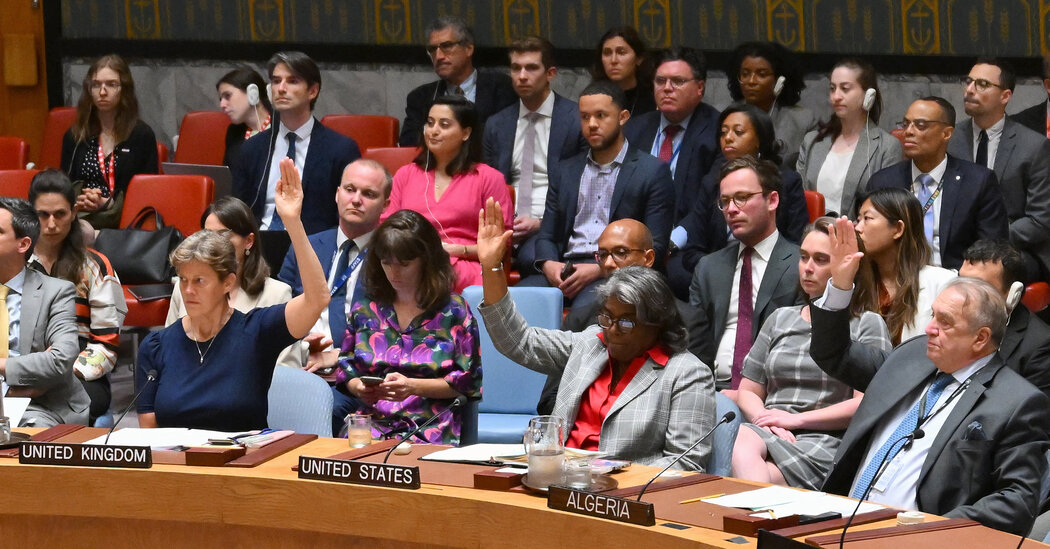The United Nations Security Council on Monday approved a U.S.-backed ceasefire plan for the Gaza Strip with only Russia abstaining, a sign of growing frustration among world powers over the war and a desire to end it.
U.S. Ambassador to the United Nations Linda Thomas-Greenfield told Security Council members that Israel had agreed to the deal set out in the resolution — even though Israel has so far refused to say so publicly — and she urged Hamas to “do the same.”
“Hamas can now see that the international community is united in its support for this agreement that will save lives and help Palestinian civilians in Gaza begin to rebuild and heal,” Ms. Thomas-Greenfield said.
The 14-0 vote may strengthen the hand of Secretary of State Antony J. Blinken, who returned to the Middle East on Monday to urge Hamas and Israel to agree to a ceasefire.
But Israel's UN ambassador, Ruth Shapir Ben-Naftali, did not say Israel had accepted the terms of the ceasefire plan, suggesting it would be difficult for Blinken and other mediators to reach a final agreement. She said Israel's goals in the war had not changed and that Israel would take military action to rescue the hostages. Just like two days ago.
“We will continue our efforts until all hostages are returned and Hamas’ military capabilities are destroyed,” Ms. Shapir Ben-Naftali told the Security Council. If Hamas leaders released all hostages and surrendered, she said, “we will not fire a single shot.”
Hamas said it welcomed parts of the resolution but did not endorse the entire plan. “Hamas stresses its willingness to cooperate with mediators in indirect negotiations,” it said in a statement.
The shift in Israeli politics over the weekend could complicate Israel’s position in ceasefire talks. Blinken met with Israeli Prime Minister Benjamin Netanyahu, whose emergency wartime government has been shaken by the exit of the centrist National Unity Party and its leader. Benny Ganzfrom Netanyahu’s wartime government.
The move emboldened far-right parties in Netanyahu's coalition that oppose a ceasefire.
It was unclear whether Israel's attack on Gaza on Saturday, which succeeded in freeing four hostages held by Hamas but left dozens of Palestinians dead, had affected the chances of Hamas agreeing to a deal.
It was not known until Monday when the Security Council voted whether veto-wielding Russia and China would allow the latest ceasefire resolution to pass. Ultimately, China voted in favor and Russia abstained.
The United States has vetoed The three previous ceasefire resolutions Since the Gaza war broke out in October, Russia and China have Veto of US resolution Because they did call for an immediate ceasefire. In March, the U.S. Allow the ceasefire resolution to be passedabstain rather than veto.
Last month, a U.S. official said the United States planned to block Algeria's draft resolution The statement described Israel as the “occupying power” in Gaza and called on Israel to immediately stop its military offensive on the city of Rafah.
The proposal, approved by the Security Council on Monday, is based on Three-phase plan President Biden proposed the plan in May. It would begin with an immediate temporary ceasefire and work to permanently end the war and rebuild Gaza. The plan also calls for the release of more than 100 prisoners held in Gaza (it is unclear how many are still alive), as well as many more Palestinians held in Israeli jails.
Blinken was making his eighth visit to the Middle East since the Hamas-led assault on Israel on Oct. 7. He stressed in a meeting with Netanyahu that the proposal “would lead to an immediate ceasefire in Gaza, the release of all hostages, and a significant and sustained increase in the distribution of humanitarian aid throughout Gaza,” State Department spokesman Matthew Miller said later.
“The secretary of state underscored the United States’ unwavering commitment to Israel’s security, including ensuring that the events of October 7 are never repeated.”
It has been more than two weeks since Israel proposed the deal to Hamas through an intermediary, but the Netanyahu government has yet to formally accept it. As of Monday, Hamas had not made any official response to the proposal.
A major sticking point is whether the deal would allow Hamas, which ruled Gaza before the war, to retain some control over the territory, which Netanyahu has called a red line.
Another issue concerns the exact timing and logistics of a ceasefire. Netanyahu has publicly stated that the Israeli offensive on Gaza must continue until Hamas' military and ability to rule are destroyed. But Hamas has made any progress on a hostage agreement conditional on Israel's commitment to a permanent ceasefire and a full withdrawal from Gaza.
The U.S. mission to the United Nations issued a statement on Sunday hinting at Gaza's post-war future, saying the ceasefire agreement would bring “a road map to a definitive end to the crisis and a multi-year reconstruction plan supported by the international community.” The statement did not provide further details or explain how Blinken plans to sell the plan to Israel and other parties in the region during his three-day trip to the Middle East.
The political process of reaching a ceasefire agreement is a complex one, both between the warring parties and at the United Nations. Extremely complex.
Blinken plans to visit Qatar during the trip. Qatar, along with Egypt, has been mediating between Israel and Hamas, which do not hold direct talks. Qatar has hosted Hamas political leaders.
Blinken's efforts are inconclusive Visits to Egypt and Qatar Last week, William J. Burns, the CIA director, and Brett McGurk, the top White House official on the Middle East, held talks to try to reach a ceasefire.
In Jordan, Mr. Blinken will attend a meeting on Tuesday on humanitarian aid to Gaza co-hosted by Jordan, Egypt and the United Nations.









